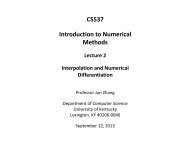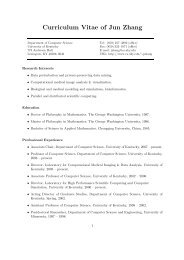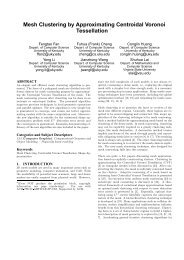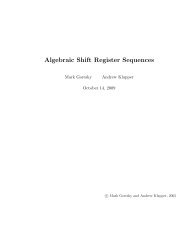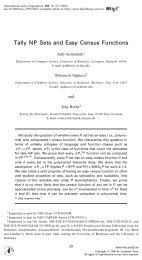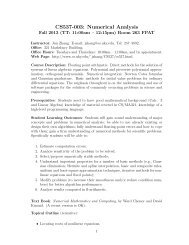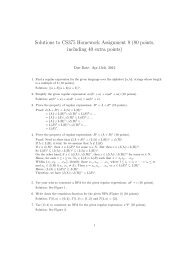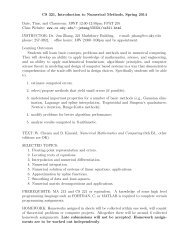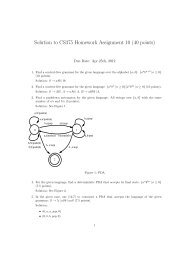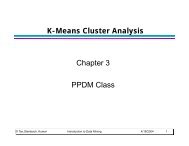Solutions of Homework 6: CS321, Fall 2010
Solutions of Homework 6: CS321, Fall 2010
Solutions of Homework 6: CS321, Fall 2010
You also want an ePaper? Increase the reach of your titles
YUMPU automatically turns print PDFs into web optimized ePapers that Google loves.
<strong>Solutions</strong> <strong>of</strong> <strong>Homework</strong> 6: <strong>CS321</strong>, <strong>Fall</strong> <strong>2010</strong><br />
Please show all steps in your work. Please be reminded that you should do your homework<br />
independently.<br />
1. (10 points) Let S 0 (x) = c 0 x + d 0 be the linear polynomial defined on [t 0 ,t 1 ], and<br />
S 2 (x) = c 2 x+d 2 the linear polynomial defined on [t 2 ,t 3 ]. We have<br />
S ′ 0 (x) = c 0, S ′ 2 (x) = c 2,<br />
and<br />
S ′′<br />
0<br />
(x) = 0, S′′ (x) = 0.<br />
2<br />
Assume the cubic spline polynomial defined on [t 1 ,t 2 ] to be S 1 (x) = a 1 x 3 +b 1 x 2 +<br />
c 1 x+d 1 . It follows that<br />
and<br />
S ′ 1 (x) = 3a 1x 2 +2b 1 x+c 1 ,<br />
S ′′<br />
1 (x) = 6a 1x+2b 1 .<br />
Since S, S ′ and S ′′ have to be continuous on [t 0 ,t 3 ], we must have<br />
Hence<br />
These two equations lead to<br />
S ′′<br />
0(t 1 ) = S ′′<br />
1(t 1 ), S ′′<br />
1(t 2 ) = S ′′<br />
2(t 2 ).<br />
6a 1 t 1 +2b 1 = 0, 6a 1 t 2 +2b 1 = 0. (1)<br />
6a 1 (t 1 −t 2 ) = 0.<br />
Since t 1 ≠ t 2 , we have a 1 = 0. From Eq. (1), we have b 1 = 0.<br />
We can now conclude that S 1 (x) = c 1 x + d 1 , so S is also a linear polynomial on<br />
[t 1 ,t 2 ].<br />
2. (10 points) Find a quadratic spline interpolant for these data<br />
x −1 0 1/2 1 2 5/2<br />
y 2 1 0 1 2 3<br />
Solution. Suppose the quadratic spline interpolant has the following form<br />
⎧<br />
Q 0 (x), x ∈ [−1,0]<br />
⎪⎨ Q 1 (x), x ∈ [0,1/2]<br />
Q(x) = Q 2 (x), x ∈ [1/2,1]<br />
Q 3 (x), x ∈ [1,2]<br />
⎪⎩<br />
Q 4 (x), x ∈ [2,5/2]
Define z i = Q ′ i (t i), the following is the formula for Q i<br />
Q i (x) = z i+1 −z i<br />
2(t i+1 −t i ) (x−t i) 2 +z i (x−t i )+y i .<br />
It follows that<br />
( ) yi+1 −y i<br />
z i+1 = −z i +2 , (0 ≤ i ≤ n−1).<br />
t i+1 −t i<br />
By setting z 0 = 0, we can compute recursively,<br />
( ) 1−2<br />
z 1 = −0+2 = −2,<br />
0−(−1)<br />
( ) 0−1<br />
z 2 = −(−2)+2 = −2,<br />
1/2−0<br />
( ) 1−0<br />
z 3 = −(−2)+2 = 6,<br />
1−1/2<br />
( ) 2−1<br />
z 4 = −6+2 = −4,<br />
2−1<br />
( ) 3−2<br />
z 5 = −(−4)+2 = 8.<br />
5/2−2<br />
Hence, the quadratic spline interpolant is<br />
⎧<br />
⎪⎨<br />
Q(x) =<br />
⎪⎩<br />
Q 0 (x) = −(x+1) 2 +2, x ∈ [−1,0]<br />
Q 1 (x) = −2x+1, x ∈ [0,1/2]<br />
Q 2 (x) = 8(x−1/2) 2 −2(x−1/2), x ∈ [1/2,1]<br />
Q 3 (x) = −5(x−1) 2 +6(x−1)+1, x ∈ [1,2]<br />
Q 4 (x) = 12(x−2) 2 −4(x−2)+2, x ∈ [2,5/2]<br />
3. (10 points) Determine if this function is a quadratic spline? Explain why or why<br />
not.<br />
⎧<br />
⎪⎨ x −∞ < x ≤ 1<br />
Q(x) = x<br />
⎪⎩<br />
2 1 ≤ x ≤ 2<br />
4 2 ≤ x < ∞<br />
Solution. Q(x) is not a quadratic spline. The domain <strong>of</strong> definition is (−∞,∞)<br />
which is not finite. Furthermore,<br />
lim (x) = lim<br />
x→1 −Q′ x→1−1 = 1,<br />
lim (x) = lim = 2.<br />
x→1 +Q′ +2x<br />
It follows that Q ′ (x) is not continuous at x = 1, which violates the definition <strong>of</strong> a<br />
quadratic spline.<br />
x→1
4. (10 points) Determine the parameters a,b,c,d and e so that S is a natural cubic<br />
spline {<br />
a+b(x−1)+c(x−1) 2 +d(x−1) 3 x ∈ [0,1]<br />
S(x) =<br />
(x−1) 3 +ex 2 −1 x ∈ [1,2]<br />
Solution. We first compute the derivatives <strong>of</strong> the individual functions<br />
S ′ 0(x) = b+2c(x−1)+3d(x−1) 2<br />
S ′′<br />
0(x) = 2c+6d(x−1)<br />
S ′ 1 (x) = 3(x−1)2 +2ex<br />
S 1 ′′ (x) = 6(x−1)+2e<br />
We will make use <strong>of</strong> the continuity condition and the definition <strong>of</strong> the natural cubic<br />
spline.<br />
From S 0 (1) = S 1 (1), we have a = c−1.<br />
From S 0 ′(1) = S′ 1 (1), we have b = 2e.<br />
From S 0 ′′ (1) = S′′ 1 (1), we have 2c = 2e, with c = e.<br />
We also have<br />
S ′′<br />
0 (0) = S′′ (2) = 0<br />
2c−6d = 0, 2e+6 = 0,<br />
we have e = −3, c = −3. Then a = e−1 = −4, b = 2e = −6, and d = c/3 = −1.<br />
5. (10 points) Determine the coefficients so that the function<br />
{<br />
x 2 +x 3 0 ≤ x ≤ 1<br />
S(x) =<br />
a+bx+cx 2 +dx 3 1 ≤ x ≤ 2<br />
is a cubic spline and has the property S 1 ′′′ (x) = 12.<br />
Solution. The derivatives are<br />
S 0 ′ (x) = 2x+3x2<br />
S 0 ′′ (x) = 2+6x<br />
S 1 ′ (x) = b+2cx+3dx2<br />
S 1 ′′ (x) = 2c+6dx<br />
S 1 ′′′ (x) = 6d<br />
Given the condition S 1 ′′′ (x) = 12, we have d = 2.<br />
By continuity, we have S 0 ′(1) = S′ 1 (1), which yields 5 = b+2c+3d.<br />
From S 0 ′′ (1) = S′′ 1 (1), we have 8 = 2c+6d.<br />
We can solve the above two equations and get c = −2 and b = 3.<br />
From S 0 (1) = S 1 (1), we have 2 = a+b+c+d, which gives us a = −1.



